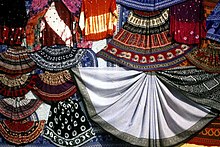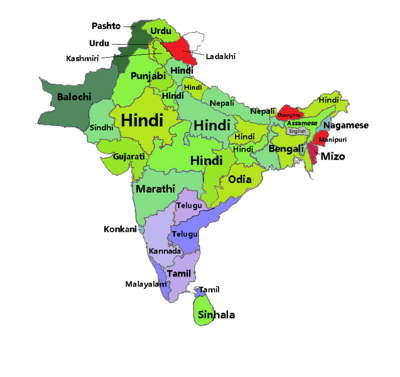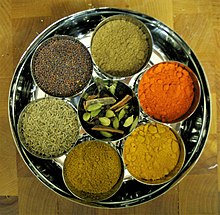Culture of South Asia

The culture of South Asia, also known as Desi culture, is a mixture of several cultures in and around the Indian subcontinent. Ancient South Asian culture was primarily based in Hinduism, which itself formed as a mixture of Vedic religion and indigenous traditions, and later Buddhist influences.[1] From the medieval era onwards, influences from the Muslim world (particularly Central Asia and the Middle East) and then Europe (primarily British) also became prevalent.[2][3]
South Asian culture has influenced other parts of Asia, particularly Southeast Asia (see Greater India).[4]
History


Evidence of
Declining climatic conditions, (
Following the Indo-Aryan settlement in the
Hinduism, Buddhism, Jainism and Sikhism are major religions of South Asia. After a long and complex history of cosmological and religious development, adoption and decline, the Hindu-synthesis[13] and the late but thorough introduction of Islam about 80% of modern-day Indians and Nepalis identify as Hindus.[14] In Sri Lanka and Bhutan most people adhere to various forms of Buddhism.[15] Islam is the predominant religion in Afghanistan, the Maldives (99%), Pakistan (96%) and Bangladesh (90%).[16][17][18]
Religion
Languages

Art
Cinema
Cuisine

Foods in this area of the world are flavoured with various types of chilli, black pepper, cloves, and other strong herbs and spices along with the flavoured butter ghee. Ginger is an ingredient that can be used in both savory and sweet recipes in cuisines from the subcontinent. Chopped ginger is fried with meat and pickled ginger is often an accompaniment to boiled rice. Ginger juice and ginger boiled in syrup are used to make desserts. Turmeric and cumin are often used to make curries.
Common meats include lamb, goat, fish, chicken andSports

Traditional sports
Some traditional South Asian games, such as
After the
Martial arts
Indian martial arts refers to the fighting systems of the Indian subcontinent. A variety of terms are used for the English phrases "Indian martial arts", deriving from ancient sources. While they may seem to imply specific disciplines (e.g. archery, armed combat), by Classical times they were used generically for all fighting systems.
Among the most common terms today,Music
Architecture
Afghan architecture
Pakistani architecture
Indian architecture
Indian architecture is rooted in the history, culture, and religion of India. Among several architectural styles and traditions, the best-known include the many varieties of Hindu temple architecture and Indo-Islamic architecture, especially Rajput architecture, Mughal architecture, South Indian architecture, and Indo-Saracenic architecture. Early Indian architecture was made from wood, which did not survive due to rotting and instability in the structures. Instead, the earliest existing architecture are made with Indian rock-cut architecture, including many Buddhist, Hindu, and Jain temples.
The Hindu temple architecture is divided into the
The first major Islamic kingdom in India was the Delhi Sultanate, which led to the development of Indo-Islamic architecture, combining Indian and Islamic features. The rule of the Mughal Empire, when Mughal architecture evolved, is regarded as the zenith of Indo-Islamic architecture, with the Taj Mahal being the high point of their contribution. Indo-Islamic architecture influenced the Rajput and Sikh styles as well.
During theDravidian architecture
Dravidian architecture, or the Southern Indian temple style, is an architectural idiom in Hindu temple architecture that emerged from Southern India, reaching its final form by the sixteenth century.
In contrast with North Indian temple styles, Dravidian architecture uses shorter and more pyramidal towers, called
Bengali architecture
The
Clothing
Literature
Philosophy
Indian philosophy consists of philosophical traditions of the Indian subcontinent. The philosophies are often called darśana meaning, "to see" or "looking at."[75][76] Ānvīkṣikī means “critical inquiry” or “investigation." Unlike darśana, ānvīkṣikī was used to refer to Indian philosophies by classical Indian philosophers, such as Chanakya in the Arthaśāstra.[76][77]
A traditional Hindu classification divides
There are six major (āstika) schools of
The main schools of Indian philosophy were formalised and recognised chiefly between 500 BCE and the late centuries of the Common Era.[citation needed] Some schools like Jainism, Buddhism, Yoga, Śaiva and Vedanta survived, but others, like Ajñana, Charvaka and Ājīvika did not.
Ancient and medieval era texts of Indian philosophies include extensive discussions onSee also
- Culture of Asia
- Category:Culture of South Asia
- Individual South Asian countries' cultures:
References
- ^ Micu, Alexandru (2020-07-01). "How old is Hinduism and how it all started". ZME Science. Retrieved 2023-09-11.
- ^ "From the Achaemenids to the Mughals: A look at India's lost Persian history". Middle East Eye. Retrieved 2023-09-11.
- ^ "How the British influenced Indian culture". DAWN.COM. 2010-06-06. Retrieved 2023-09-11.
- ^ Pillalamarri, Akhilesh. "How India Influenced Southeast Asian Civilization". thediplomat.com. Retrieved 2023-09-11.
- PMID 22645375.)
{{cite journal}}: CS1 maint: multiple names: authors list (link - ISBN 9780521871648. Retrieved April 21, 2018.
- ^ Kenoyer 1991.
- ^ Coningham & Young 2015, p. 27.
- ISBN 9781603849036. Retrieved April 21, 2018.
- ISBN 9788131711200. Retrieved April 22, 2018.
- ^ Upinder Singh, A History of Ancient and Early Mediaeval India 2008, p. 200.
- ^ Michael Witzel. "The Development of the Vedic Canon and its Schools : The Social and Political Milieu" (PDF). Harvard University. Retrieved April 22, 2018.
- ^ "Hindu synthesis and smriti". Speaking Tree. Retrieved April 22, 2018.
- ^ "The Global Religious Landscape – Hinduism". A Report on the Size and Distribution of the World's Major Religious Groups as of 2010. Pew Research Foundation. 18 December 2012. Retrieved April 21, 2018.
- ^ Pew Research Center (18 December 2012). "Global Religious Landscape: Buddhists". Pew Research Center. Retrieved April 21, 2018.
- ISBN 9780415448512.
- ^ "10 Countries With the Largest Muslim Populations, 2010 and 2050date=2015-04-02". Pew Research Center's Religion & Public Life Project. Retrieved April 21, 2018.
- ^ Diplomat, Akhilesh Pillalamarri, The. "How South Asia Will Save Global Islam". The Diplomat. Retrieved April 21, 2018.
{{cite news}}: CS1 maint: multiple names: authors list (link) - ^ Peter R. Blood. "Pakistan : a country study". Library of Congress. Retrieved April 22, 2018.
- ISBN 9788125001881. Retrieved 2018-01-15.
- ^ http://himalaya.socanth.cam.ac.uk/collections/journals/contributions/pdf/CNAS_26_02_01.pdf
- ^ Mendis, V.L.B (1985). Foreign Relations of Sri Lanka: Earliest Times to 1965. Tisara Prakasakayo. pp. 113–16.
- ISBN 978-9004056602. Retrieved 2018-01-15.
- ISBN 978-1-316-58235-0.
- ISBN 978-3-11-081566-5.
- ISBN 978-1-4438-6761-0.
- ISBN 978-0-252-06172-1.
- ISBN 978-0-14-341639-5.
- ^ "Hindi, Hinglish: Head to Head". read.dukeupress.edu. Retrieved 2023-10-29.
- ^ Salwathura, A. N. "Evolutionary development of ‘hinglish’language within the indian sub-continent." International Journal of Research-GRANTHAALAYAH. Vol. 8. No. 11. Granthaalayah Publications and Printers, 2020. 41-48.
- ^ Vanita, Ruth (2009-04-01). "Eloquent Parrots; Mixed Language and the Examples of Hinglish and Rekhti". International Institute for Asian Studies Newsletter (50): 16–17.
- ISSN 0019-0829.
- S2CID 59247503.
- ^ "Explained snippets: Cricket has 1 billion fans, 90% of them in subcontinent". The Indian Express. 2018-06-28. Retrieved 2023-08-14.
- ISBN 978-0-203-06643-0, retrieved 2024-05-29
- ISBN 978-0-7146-5146-0.
- ^ Bastian, Ron (2022-11-13). "For football-crazy Kerala, FIFA World Cup is its biggest festival". thefederal.com. Retrieved 2023-08-14.
- ^ "Why Bengal is obsessed with football?". The Indian Express. 2018-06-14. Retrieved 2023-08-14.
- ^ "50 years of Victory: What has Bangladesh achieved in the field of sports?". The Business Standard. 2021-12-16. Retrieved 2023-08-14.
- ^ History of hockey in India: Taught by the British, India conquered the world https://olympics.com/ Rahul Venkat
- ^ Taneja, Nidhima (2023-01-27). "Pro kabaddi, kho-kho leagues chase IPL viewership. India rediscovering regional sports". ThePrint. Retrieved 2023-08-14.
- ^ "OCA » Ancient tag game of kho kho catching on fast". ocasia.org. Retrieved 2023-08-14.
- ^ Kabaddi: How to play India’s 4000-year-old indigenous sport Olympics.com
- ^ Kho Kho, a kabaddi-like sport linked with Indian epic Mahabharata – know all about it Olympics.com
- ^ Arasu, S. T. (4 July 2020). "Galah Panjang and its Indian roots". On the sport. Be part of it. Retrieved 2022-11-19.
- ^ "The Evolution Of Kho Kho Mats In India: A Historical Overview". English Jagran. 2023-05-30. Retrieved 2023-08-08.
- ^ A Historical Study of the Origin and Features of Some Selected Folk Games in North Bengal Badal Roy https://ir.nbu.ac.in/
- ^ Disappearance of Traditional games by the imitation of Colonial Culture through the Historical parameters of Cultural Colonialism Md Abu Nasim https://dergipark.org.tr/
- ^ Games and Sports in West Bengal under Global Urbanization: An Ethnographic Approach Dr. Abhijit Das http://www.ijhssi.org/
- ^ Bengal Traditional Games and Sports Culture Around in Twentieth-Century North Bengal Badal Roy & Dr. Sudash Lamahttps://ir.nbu.ac.in/
- ^ Pant, Charu (16 August 2015). "Five Indian Origin Games on the verge of extinction – Sports". Retrieved 2022-11-19.
- ^ TRADITIONAL GAMES AND SPORTS Siben Paul http://oldror.lbp.world/
- ^ Folk Games Dying in Pashtun Belt: A Combination of Religious Extremism Confining Girls to Their Homes and Urbanisation Providing New Options nayadaur.tv
- ^ India's defeat reflects Kabaddi's globalisation: Coach Reddy https://www.business-standard.com/
- ^ "Format, game tweaks have helped draw fans on TV: Ultimate kho kho CEO". Hindustan Times. 3 September 2022. Retrieved 2022-11-19.
- ^ Taneja, Nidhima (2023-01-27). "Pro kabaddi, kho-kho leagues chase IPL viewership. India rediscovering regional sports". ThePrint. Retrieved 2023-08-08.
- Classical Sanskrit only, specifically in the Anargharāghava.
- ISBN 978-1-58160-480-1.
- ^ "Actualizing Power and Crafting a Self in Kalarippayattu". Spa.ex.ac.uk. Retrieved 27 September 2015.
- ISBN 978-0-8239-3179-8.
- ISBN 9788120805927.
- S2CID 193335418.
- JSTOR 834451.
- ISBN 978-1-85043-436-8.
- ISBN 978-1-610-69778-1.
- ISBN 0-7524-2519-6.
- OCLC 50488428.
- ^ Guisepi, R.A. . Retrieved on February 6, 2008
- ^ Meister, M.W. (1997). Gandhara-Nagara Temples of the Salt Range and the Indus. Kala, the Journal of Indian Art History Congress. Vol 4 (1997-98), pp. 45-52.
- ^ See Raj Jadhav, pp. 7–13 in Modern Traditions: Contemporary Architecture in India.
- ^ Fergusson, James (1864). The Rock-cut Temples of India: Illustrated by Seventy-four Photographs Taken on the Spot by Major Gill. J. Murray.
- ISBN 978-0-470-02827-8.
- ISSN 0971-751X. Retrieved 2022-05-13.
- ^ Nakassis, Constantine & Annamalai, E. (2020). Linguistic Diversity in South Asia, Reconsidered. University of Chicago. pp. 1–21.
{{cite book}}: CS1 maint: multiple names: authors list (link) - ^ "Monier-Williams Sanskrit Dictionary 1899 Basic". www.sanskrit-lexicon.uni-koeln.de. Retrieved 2024-05-24.
- ^ ISBN 978-0-19-885176-9.
- ISBN 978-0-19-989182-5.
- ^ Bowker 1999, p. 259.
- ^ Doniger 2014, p. 46.
- ^ Nicholson 2010, Chapter 9.
- ^ Cowell & Gough 2001, p. xii.
- ^ Nicholson 2010, pp. 158–162.
- ^ Perrett, Vol. 3 2000.
- ISBN 978-1-136-51898-0.
- ISBN 9789993624318.
- ISBN 978-0-7546-3301-3.
Referenced works
- Kenoyer, Jonathan Mark (1991), "The Indus Valley tradition of Pakistan and Western India", Journal of World Prehistory, 5 (4): 1–64, S2CID 41175522
- Coningham, Robin; Young, Ruth (2015), Archaeology of South Asia: From the Indus to Asoka, c.6500 BCE–200 CE, Cambridge University Press
- ISBN 978-81-317-1120-0
- Bowker, John, ed. (1999). The Oxford Dictionary of World Religions. Oxford University Press. ISBN 978-0-19-866242-6.
- ISBN 978-0-19-936008-6. Archivedfrom the original on 30 January 2017.
- Nicholson, Andrew J. (2010). ISBN 978-0-231-14987-7.
- Acharya, Mādhava (1894). The Sarva-darśana-samgraha: Or, Review of the Different Systems of Hindu Philosophy. Translated by Cowell, E. B.; Gough, A. E. London: Trübner & Company.
- Perrett, Roy W. (1984). "The Problem of Induction in Indian Philosophy". JSTOR 1398916.
- Perrett, Roy W., ed. (2000). Indian Philosophy : A Collection of Readings, Volume 3: Metaphysics. Garland. ISBN 978-0-8153-3608-2.
- Acharya, Mādhava (1894). The Sarva-darśana-samgraha: Or, Review of the Different Systems of Hindu Philosophy. Translated by Cowell, E. B.; Gough, A. E. London: Trübner & Company.
- Cowell, E. B.; Gough, A. E. (2001). The Sarva-Darsana-Samgraha or Review of the Different Systems of Hindu Philosophy. Trubner's Oriental Series. Taylor & Francis. ISBN 978-0-415-24517-3.
